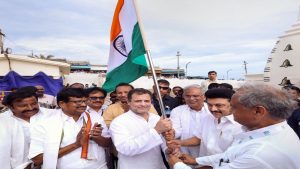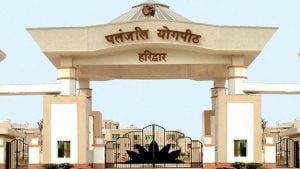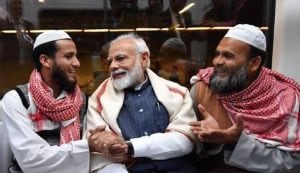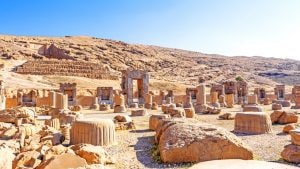2024 Lok Sabha Elections | These are the five key demographic outreaches of the BJP

KV Prasad Jun 13, 2022, 06:35 AM IST (Published)
 Listen to the Article (6 Minutes)
Listen to the Article (6 Minutes)
Summary
BJP’s evolving approach toward Pasmanda Muslims marks a significant shift in its electoral tactics, with the forthcoming elections poised to reveal the efficacy of these endeavours, observes political analyst Prof. Sayantan Ghosh.
Under the stewardship of Prime Minister Narendra Modi, the Bharatiya Janata Party (BJP) has set an ambitious goal for the upcoming Lok Sabha elections — to secure over 400 seats. As the first phase of voting gets over, it’s crucial to examine the party’s key strategy to achieve this landmark figure.
Unlike the Congress party, which has deep historical and cultural roots in India, the BJP’s past isn’t as intertwined with the nation’s history. This has led the BJP to focus on demographic outreach, particularly towards various communities, including minorities.
The 2024 elections aren’t the first instance of such an outreach. The BJP and its parent organisation, the Rashtriya Swayamsevak Sangh, have consistently worked on demographic outreach and cultural appropriation. However, the intensity of this focus has significantly increased in the run-up to the 2024 elections.
The BJP’s outreach is comprehensive, targeting Pasmanda Muslims, the Christian community, and appropriating Dravidian culture. It also includes extensive Scheduled Castes and Scheduled Tribes outreach programs across various states and efforts to connect with communities like the Jats of Uttar Pradesh. This broad-based approach is a testament to the BJP’s commitment to inclusivity and its ambition to create a pan-Indian appeal.
Outreach to Pasmanda Muslims— A Game Changer for the 2024 Elections
As the campaigns started, the BJP embarked on a strategic approach to engage with communities, including the Pasmanda Muslims. The term ‘Pasmanda’, originating from Persian, denotes ‘those left behind,’ referring to a community comprising 85% of India’s total Muslim population, often marginalised both socially and economically. Historically, the BJP has not courted Muslim voters, considering them largely opposed to the party’s ideology, although occasional attempts at Muslim outreach by the RSS have not yielded significant results.
Prime Minister Narendra Modi has notably highlighted the plight of Pasmanda Muslims in his speeches, advocating for their upliftment. However, scepticism lingers within the Pasmanda community regarding these gestures, given past political dynamics. The BJP’s recent efforts include offering ministerial positions to Pasmanda representatives, such as Danish Ansari in the Uttar Pradesh Cabinet, and disseminating information about government welfare programs targeted at the economically disadvantaged.
This outreach forms part of the BJP’s broader strategy to diversify its support base and position itself as a proponent of the marginalised. Yet, the true impact of these initiatives will only be discernible after the 2024 elections. The BJP’s evolving approach toward Pasmanda Muslims marks a significant shift in its electoral tactics, with the forthcoming elections poised to reveal the efficacy of these endeavours.
While some view the BJP’s overtures to Pasmanda Muslims as a politically calculated move aimed at diluting opposition support among minority communities, others see it as a genuine attempt to address the socio-economic disparities faced by this segment of the population. The party’s emphasis on offering ministerial positions and promoting awareness of welfare schemes underscores its commitment to inclusive governance.
However, challenges persist in winning over the trust and support of Pasmanda Muslims, who remain wary of political rhetoric and seek tangible improvements in their socio-economic conditions. The BJP’s track record of delivering on its promises to marginalised communities will play a crucial role in shaping perceptions and influencing electoral outcomes.
Overall, the BJP’s outreach to Pasmanda Muslims signifies a nuanced approach to electoral politics, recognising the importance of engaging with diverse demographics and addressing their specific needs. As the political landscape evolves and election dynamics unfold, the impact of these efforts on the BJP’s electoral fortunes will become clearer, highlighting the complex interplay between identity politics, socio-economic development, and electoral strategy in India’s democratic process.
BJP’s Outreach to the Christian Community
In the lead-up to the 2024 Lok Sabha elections, the Bharatiya Janata Party (BJP) has taken decisive steps to engage with the Christian community, signalling a strategic shift in its electoral approach. This outreach initiative is part of a broader strategy aimed at diversifying its voter base and projecting a more inclusive image.
The BJP’s efforts to connect with the Christian community have been multifaceted. From organising Christmas outreach programs to active participation in church events, the party has sought to foster trust and understanding within this demographic. Key moments, such as party president JP Nadda’s visit to the Sacred Heart Cathedral Catholic Church and Prime Minister Narendra Modi’s hosting of a special Christmas program, have underscored the BJP’s commitment to acknowledging and appreciating the community’s contributions.
Despite these proactive measures, there remains a perceptible gap between the BJP’s outreach and the sentiments prevalent within the Christian community. While these efforts are seen as a strategic move to challenge the opposition’s hold on minority votes, their effectiveness in resonating with the community’s core concerns and values remains a subject of ongoing scrutiny.
In states like Kerala, where Christians hold significant electoral sway, the BJP’s engagement efforts have gained added importance. Programs like ‘Sneha Yatra’ and Vishu breakfasts have been launched to foster connections and build rapport. However, the reception within the community has varied, highlighting the nuanced dynamics at play.
BJP’s Dravidian Odyssey: A Strategic Shift
As the 2024 Lok Sabha elections draw near, the Bharatiya Janata Party (BJP) has embarked on a notable journey to embrace Dravidian culture, signalling a strategic evolution in its electoral playbook. This endeavour is part of a larger strategy aimed at broadening its voter base and projecting a more inclusive identity.
The BJP’s endeavours to penetrate the Dravidian stronghold in Tamil Nadu have been persistent and purposeful over recent years. The party’s concerted efforts, spearheaded by proactive state chief K. Annamalai, reflect a determination to navigate and overcome the barriers posed by Dravidian politics.
Unlike aligning with established Dravidian parties that have long dominated Tamil Nadu’s political landscape, the BJP, under Prime Minister Narendra Modi’s leadership, is forging its path as a distinct third force. By forming alliances with regional players like the Pattali Makkal Katchi (PMK), Tamil Manila Congress (TMC), and Amma Makkal Munnetra Kazhagam (AMMK), the BJP is strategically positioning itself to challenge traditional political narratives.
Prime Minister Modi’s frequent visits to Tamil Nadu underscore the BJP’s commitment to this strategic endeavour, aiming not just for a presence but a substantial increase in its vote share within the state.
The BJP’s appropriation of Dravidian culture represents a calculated move to redefine its electoral narrative in Tamil Nadu. While the success of this strategy in the 2024 elections remains uncertain, it reflects the BJP’s adaptability and ambition to carve out a distinct political space in a historically entrenched political arena.
The BJP’s Jat Connection: A Strategic Shift in Uttar Pradesh Politics
As the 2024 Lok Sabha elections loom closer, the Bharatiya Janata Party (BJP) has embarked on a determined quest to mend fences and win over the Jat community in Uttar Pradesh. This outreach effort is not merely a political manoeuvre but a strategic shift aimed at broadening the party’s support base and projecting a more inclusive image.
The Jats, once disenchanted with the BJP over the contentious farm laws, have become the focal point of the party’s campaign. The BJP’s tireless outreach efforts, including grassroots engagement and door-to-door canvassing, specifically target Jat voters to regain their trust and support.
A masterstroke in the BJP’s strategy has been the posthumous recognition of Chaudhary Charan Singh, a revered Jat leader, with the prestigious Bharat Ratna award. This move has not only appeased the Jat community but has also facilitated the Rashtriya Lok Dal’s (RLD) alignment with the National Democratic Alliance (NDA), adding significant electoral leverage, especially in western Uttar Pradesh.
The RLD’s strategic realignment with the NDA, bringing a substantial Jat vote bank into the fold, marks a pivotal moment in Uttar Pradesh politics. It underscores the BJP’s proactive approach and adaptability, positioning itself for a formidable electoral showing in the upcoming Lok Sabha elections.
In essence, the BJP’s outreach to the Jat community and its strategic leveraging of Chaudhary Charan Singh’s legacy symbolise a calculated electoral strategy with far-reaching implications. The unfolding electoral landscape will determine the efficacy of these efforts in securing electoral dividends for the BJP in 2024.
BJP’s Strategic Outreach to the SC/ST-OBC Community
As part of the election strategy, the Bharatiya Janata Party (BJP) is actively engaging with the SC/ST-OBC community, showcasing a determined effort to broaden its electoral base and portray a more inclusive stance.
The BJP’s outreach initiatives towards the SC/ST-OBC demographic have been vigorous, employing grassroots campaigns and community-centric events to garner support. Noteworthy among these efforts was the ‘OBC Mahakumbh’ organised in Prayagraj, signalling a concerted effort to connect with backward classes ahead of the impending general elections.
A strategic move in the BJP’s outreach playbook was the posthumous award of the Bharat Ratna to Kapoori Thakur, a revered OBC leader. This gesture not only resonated positively within the OBC community but also facilitated the return of Nitish Kumar, Bihar’s Chief Minister, to the NDA fold, strengthening the BJP’s political alliances.
Furthermore, the BJP’s engagement with the Matua community in West Bengal, particularly through the implementation of the Citizenship Amendment Act (CAA), underscores the party’s nuanced approach to engaging diverse voter segments, especially those with specific concerns and aspirations.
The BJP’s proactive engagement with the SC/ST-OBC community signifies a strategic evolution in its electoral agenda. However, the electoral impact of these initiatives in the 2024 Lok Sabha elections remains a subject of keen observation, poised to define the party’s electoral trajectory in the coming years.
—The author, Sayantan Ghosh (@sayantan_gh), is a political observer and a research scholar, who teaches journalism at St. Xavier’s College (autonomous), Kolkata. The views expressed are personal.

Elon Musk forms several ‘X Holdings’ companies to fund potential Twitter buyout
3 Mins Read
Thursday’s filing dispelled some doubts, though Musk still has work to do. He and his advisers will spend the coming days vetting potential investors for the equity portion of his offer, according to people familiar with the matter

KV Prasad Journo follow politics, process in Parliament and US Congress. Former Congressional APSA-Fulbright Fellow



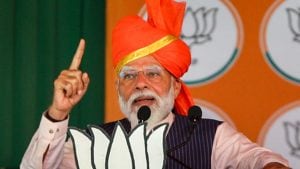






 Listen to the Article
Listen to the Article  Daily Newsletter
Daily Newsletter





